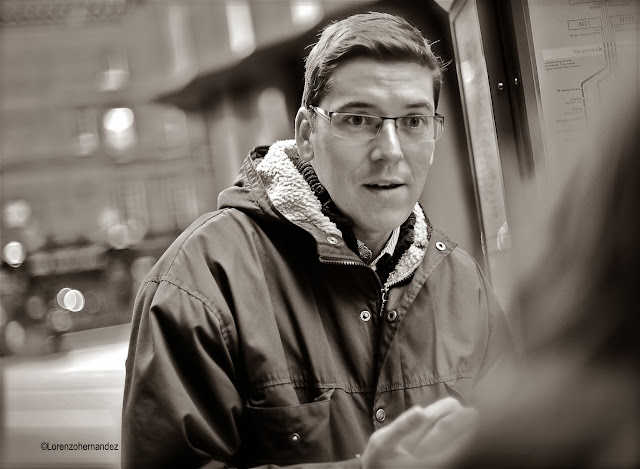A couple of
Sundays ago, Lorenzo and I were walking along the north bank of the river
Thames from Battersea Park towards Covent Garden, where we were going to meet our
daughter Carla. It was dark
already, which is not amazing at this time of the year. Suddenly, we came
across the Tate Gallery and decided to go in. In London it’s not unusual to
find galleries and museums open till late, so we decided to go in. The Tate has
just opened its door to a newly refurbished building and we were looking forward
to seeing it. At that time of the evening, all was quiet and we had the Tate
all to ourselves. We could see works by Francis Bacon and Lucian Freud in
perfect solitude, as if they were hanged in our own living room. There was also
a very interesting exhibition of the work of Japanese photographer Daido Moriyama.
All was quiet and peaceful, nobody disturbed us.
We were
thinking about leaving when, all of a sudden, a door opened and a group of
people appeared. They obviously didn’t expect to find us there. “How did you
get in? The museum has been closed for half an hour”. Apparently nobody had
noticed how we had entered through the main gate. They were really worried
because we could have been locked for the whole night. Imagine, like in the famous film. A very nice lady accompanied us to one of the side exits and we talked
about the renovation. At the end, we had our own little private visit.

Some days
later, we decided to go to another museum after dark. This time it was the
Victoria and Albert Museum, which celebrates free events on the last Friday of
the month. This was the last of the year, as the next one will take place on
January 31st and we didn’t want to miss it. This
evening the topic was Rules of Adornment
and there were installations and performances, workshops, conferences, films,
catwalk shows and DJs, all revolving around the topic of body decoration and
identity.

When we
arrived, we were greeted by the sounds of DJs Sam Peet and Tim Parker. The
museum didn’t look as the one we had visited with Darren one week before. It
looked like a big party, full of trendy people holding wine glasses and talking
among the statues next to the great hall, mixing with a group of waif models
that paraded Wha Lim collection, an emerald green dystopic version of Renaissance. Lorenzo took out his
camera and started to shoot. There were dozens of people taking pictures at that
very moment, but the models decided to pose for him.
Next, we
moved to the Sackler centre, where the ilustration, graphic design and image
making collective Brothers of the Stripe
were holding a workshop.
The artists were decorating the glass surface of the door and the walls of the room with different shapes of letters and illustrations in black and light blue.
In the middle of the room there was a long table where you could choose a poster with a character design by the artists (a thug, a pin-up, an octopus...) and tatoo it using stamps of different shapes. It was really good fun, as you can see in the photos.
Then we
left the room and spent some time listening to the best music of the night,
played by DJ, sound artist and composer Gyorgy Ono, while having fun in one of
the spinning chairs you could find at the hall of the Sackler centre. Here you
can see me falling back while holding the octopus I had just decorated.
Ono’s music
was hypnotic and we spent some very relaxed and pleasant minutes looking at the
people around, most of them in their early twenties but dressed exactly with
the same clothes my friends and I used to wear in the early 1980s: black
trousers too short to reach the ankles, shoes with thick soles, and long flowery
shirts we never tucked in. It was like a blast from the past.
Then it was
time to have a break and we moved to the museum cafeteria, where we enjoyed a
wonderful piano concerto while sipping a drink. The pianist had the most
amazing hands, elongated and curved from the wrist, as if they were a product
of millions of years of evolution: hands perfectly adapted to playing at the
speed of a cheetah.
We were
about to leave the museum when Lorenzo had to take his camera out again. A
group of cat women with their faces covered by masks of jewellery was coming
down the stairs.
The sinuous movement of the models bewitched the observer.
But
the best photo came at the end, when they retired to the adjacent room and sat
for a moment to rest. Here you can see the vulnerability behind the mask.
Two nights
at the museum, two new experiences.









































